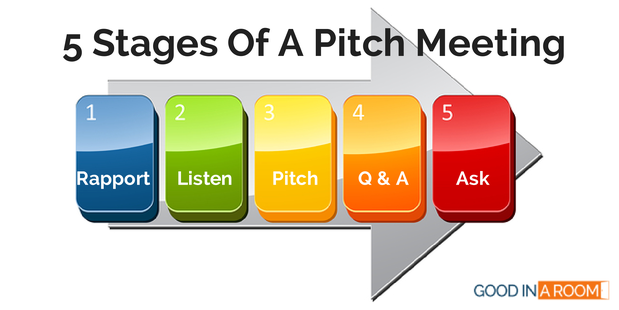Pitch Meetings Structure Stage 5: Ask for one thing if necessary and leave on a good note.

Pitch Meeting Stage 5: The Close
The goal: to leave on a positive note
It’s likely that the decision-maker will end the meeting, so you want to be ready for when that happens. Typically, there is a non-verbal cue that the meeting is over, and your job is to “echo” the cue.
Watch for when the decision-maker:
- Gets ready to get out of his or her chair
- Places hands flat on their lap or the table
- Closes a notebook or a folder
When you see one or more of these non-verbal cues, echo it back by gathering your materials and preparing to leave.
Then, you can engage in a little more rapport building—like a bookend to Stage 1. The purpose of this isn’t to reignite the conversation, it’s just to end on a personal, positive note. It can be something simple, e.g.:
- “Tell (common friend) I said hi.”
- “Thanks again for the tip about Orochan. I’ll check it out!”
The trap: continuing the conversation
When the decision-maker ends the meeting, don’t try to pitch “one more thing.” Don’t ask any more questions. Don’t tell a story. Just make sure you’ve got everything packed up, prepare to shake hands, and exit the room smoothly.
Key tactic: prepare a specific request (aka, the “Ask”)
You may not need to make a request of the decision-maker. Often, they may say something like, “I’m sending this to my boss today. Keep your phone on.”
However, it’s a good idea to have a request prepared just in case you need it, e.g.:
- “How should I follow up with you?”
- “Whom do you recommend I get in touch with?”
Understanding Structure = Confidence
When you understand meeting structure and have prepared tactics for each of the five stages, it looks like you’re poised and confident. And as you accumulate success over time, it doesn’t just look that way—it feels that way, too.
Keep in mind, there is a wide variety in how the five stages can be handled. You may spend more time in one stage than you expect. But when you know the goal of each stage, the trap to avoid, and the key tactic to use, you’ll be able to confidently handle whatever comes your way.
This article is over at Good in a Room | Stephanie Palmer

